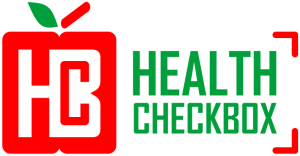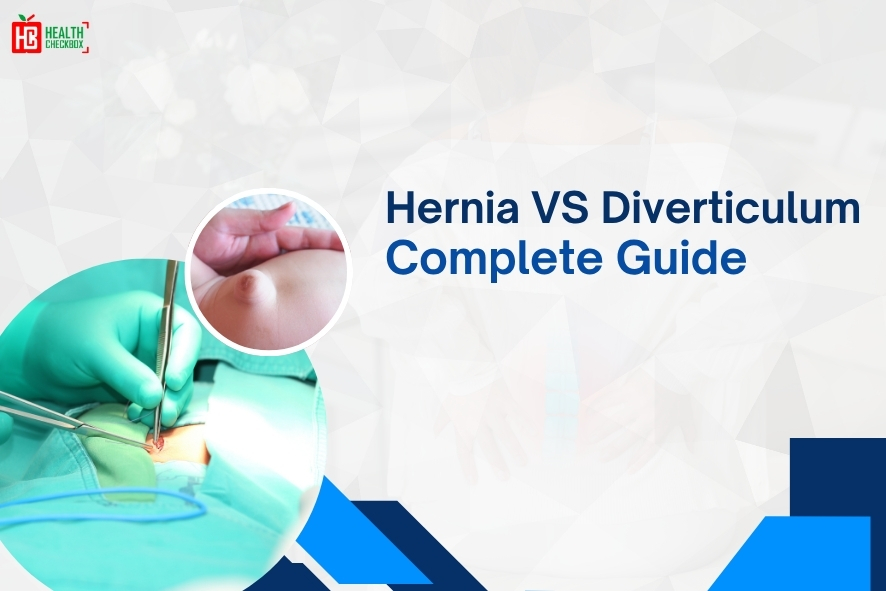Understand the Hernia vs Diverticulum, both are common abdominal conditions. Most of the patients are confused by the similarity in terms of these conditions. If we talk about hernia, it affects the muscle wall, and a diverticulum is an intestinal pouch. In this blog, we will discuss the key difference between a hernia and a diverticulum, and also explore their causes, symptoms, diagnosis, treatment options, and tips for recovery.
What is a Hernia?
A hernia happens when an internal body part, such as an organ or fatty tissue, pushes through a weak spot in the surrounding muscle or connective tissue. Aging and regular muscle wear and tear can cause hernias. This produces a visible or sometimes tender bulge, particularly on straining, lifting, or coughing. They can also be affected by injury, surgery, and birth disorders.
What is a Diverticulum?
A diverticulum occurs in the small pouches or pockets in the inside wall of your intestines. When the inside lining of your intestines pushes into the weak spots of the outer wall, that is the time to develop a diverticulum. This condition is commonly found in those over 40. Most people know this condition from the name diverticulosis. The term “diverticulosis” comes from the word “diverticulum,” which means that the path through your intestines diverges into these side pockets.
Differences Between Hernia and Diverticulum
Here is a simple comparison of the hernia and diverticulum, followed by a brief explanation:
Causes: Hernia VS Diverticulum
Check out the causes of hernia and diverticulum:
Causes of Hernia
- Heavy Lifting: Lifting heavy weights, especially when you have no weight-lifting training.
- Chronic Coughing or Sneezing: Repetitive pressure from chronic respiratory disorders (e.g, COPD, asthma, allergies).
- Constipation: Increases pressure within the abdomen, especially with regular straining.
- Obesity: Extra weight on the body also puts pressure on the abdominal muscles.
- Pregnancy: Stretches and weak abdominal muscles also raise the risk of hernias.
- Aging: Muscles also weaken day by day with age, which creates a chance of a hernia.
Causes of Diverticulum
- Low-Fiber Diet: A low-fiber diet makes it harder and causes constipation, which increases pressure within the colon and leads to pouches.
- Chronic Constipation: Constant straining during stool passage increases colon pressure and contributes to pouch formation.
- Aging: The wall of the colon weakens with age, and diverticulosis occurs more often in individuals over age 40.
- Obesity: Raises pressure within the abdomen, and it is associated with an increased risk of diverticulitis.
- Physical Inactivity: An Inactive lifestyle delays digestion, making one more prone to constipation and diverticulum development.
- Smoking: Linked with a greater risk of complications such as diverticulitis.
Types: Hernia VS Diverticulum
Here are the types of hernia and diverticulum:
Types of Hernia
- Inguinal Hernia
- Where it is: Groin region (inguinal canal)
- Who it occurs in: More prevalent in men
- Description: The Intestine or bladder pushes through the wall of the abdomen or into the inguinal canal. This is the most frequent type of hernia.
- Femoral Hernia
- Where it is: Top thigh, just beneath the groin
- Who it occurs in: More prevalent in women
- Description: Fat tissue or section of the intestine bulges into the femoral canal. Less frequent but more dangerous due to the greater likelihood of complications.
- Umbilical Hernia
- Location: Belly button (navel)
- Who it affects: Found in infants, but can occur in adults
- Details: When an intestine bulges through a weak spot in the belly wall close to the navel.
- Hiatal Hernia
- Location: Diaphragm (where the esophagus and stomach meet)
- Who it affects: Usually occurs in individuals over 50
- Details: The stomach bulges upward into the chest through the diaphragm. May result in acid reflux or GERD.
- Incisional Hernia
- Location: Where there has been a prior surgical cut.
- Who it impacts: Individuals who have undergone surgery on the abdomen.
- Description: Tissue bulges through the scar or point of weakness in the abdominal wall.
Types of Diverticulum
- Colonic Diverticulum
- Location: Large intestine
- Affected Population: Older adults and usually those above 60 years of age.
- Description: Small pouches (pseudodiverticula) bulge through weak spots in the colon walls. They are usually asymptomatic but may cause diverticulitis or bleeding.
- Meckel’s Diverticulum
- Location: Ileum (distal part of small intestine).
- Affected Population: Genetic, seen in children but often discovered late.
- Description: It is a true diverticulum with all layers of the intestinal wall present; gastric or pancreatic tissue may be found there. It follows the Rule of 2s.
- Zenker’s Diverticulum
- Location: Upper esophagus, just behind the throat.
- Affected Population: Elderly adults, males are more often affected.
- Description: Pouch formation occurs at the pharyngoesophageal junction due to pressure buildup and sometimes serves as a bag for halitosis, regurgitation, and aspiration.
- Duodenal Diverticulum
- Location: Duodenum (the proximal part of the small intestine).
- Affected Population: Middle-aged and older adults.
- Description: Mostly asymptomatic. It can pose a problem near the bile duct with an obstruction of either the biliary or pancreatic ducts.
- Epiphrenic Diverticulum
- Location: Lower esophagus, just above the diaphragm.
- Who it affects: Adults with esophageal motility disorders.
- Description: Outpouching caused by high pressure. Can lead to difficulty swallowing, regurgitation, or aspiration.
Symptoms: Hernia and Diverticulum
Here are some common symptoms of hernia and diverticulum:
Symptoms of Hernia
- Visible Bulge or Lump
- Pain or Discomfort at the Local Site
- Heaviness or Pressure
- Swelling or Tenderness
- Post-Activity Symptom Changes
Symptoms of Diverticulum
- Lower-Left-Abdominal Pain: The most common symptom, especially in diverticulitis. Usually an intense pain, constant, and growing in intensity.
- Bloating and Discomfort in the Abdomen: Common during diverticulosis (the uncomplicated formation of diverticulitis) and often occurring after eating.
- Changes in Bowel Habits: Includes constipation, diarrhea, or interchange between the two.
- Fever and Chills: The signs of infection or inflammation while in diverticulitis.
- Nausea and Vomiting: Usually seen in the severe form of diverticulitis and may indicate the involvement of the intestines.
Treatment Options: Hernia VS Diverticulum
Take a look at the treatment options for hernia and diverticulum:
Treatment Options for Hernia
Here are some surgical options for hernia treatment:
- Watchful Waiting (Non-Surgical Treatment)
- Ideal for small and asymptomatic hernias.
- Lifestyle modifications may be suggested, coupled with intermittent checks.
- Not a permanent solution since hernias do not spontaneously regress.
Lifestyle Suggestions Include:
- Avoid lifting heavy weights or straining.
- Keeping handy a healthy weight.
- Adequate treatment for chronic cough or constipation.
- Wearing support garments (hernia belts) for relief.
- Surgical Treatment
Surgery is the only option that cures most hernias and is advised if hernias are enlarging and painful, or threatened with strangulation.
(a) Open Hernia Repair (Herniorrhaphy or Hernioplasty)
- A very normal means of accessing the hernia is through an incision directly over the site of the hernia.
- The herniated tissue is pushed back into place, and the muscle wall incised and repaired, often with a patch of mesh.
(b) Laparoscopic Hernia Repair
- A minimally invasive technique with small incisions and a camera.
- Faster recovery and less postoperative pain than open procedures.
- Mostly used in cases of inguinal or abdominal hernias.
(c) Robotic-Instrumented Surgery
- A more precise approach than laparoscopic surgery that uses robotic arms.
- Best for complex and recurrent hernias.
Treatment Options for Diverticulum
1. Medical Treatment (for Mild Diverticulitis)
Mild cases usually can be treated at home under the doctor’s supervision. Treatment may include:
- Antibiotics (metronidazole and ciprofloxacin): Treat the infection.
- Clear Liquid Diet: Rest the bowel for a few days.
- Pain Relievers: Use acetaminophen whenever possible to avoid GI irritation.
2. Hospitalization (for Patients with Moderate-to-Severe Diverticulitis)
If one presents with worse symptoms or has risk factors (e.g., elderly, immunocompromised), admission to the hospital may be warranted. Treatment may include:
- IV Antibiotics and Fluids
- NPO to rest the bowel
- Close monitoring for the development of complications (abscess, perforation)
3. Surgery (for Recurrent or Complicated Diverticulitis)
Surgery is considered in the following:
- Multiple recurrent episodes.
- Complications such as abscesses, fistulas, perforations, or obstructions.
- An immunocompromised host is at risk of precipitating a severe infection.
The surgical options are:
(a) Bowel Resection (Colectomy)
- An affected and diseased part of the colon is surgically removed.
- The healthy ends are stitched together (primary anastomosis), or a temporary colostomy may be performed.
(b) Laparoscopic Surgery
- Minimally invasive with a quicker recovery.
- Laparoscopy is done only in elective cases where the treatment can’t be delayed for any urgent situation.
Conclusion
Hernias and diverticula are both involved in abdominal protrusions of the body. The functionality is different between both of them, like their causes, locations, symptoms, and the process of treatment. We discovered all the essential key differences in hernia vs diverticulum. If you are experiencing symptoms like pain, swelling, and digestive issues, then you have to seek a health specialist.

